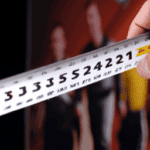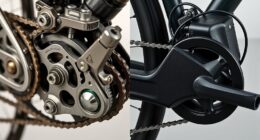Professional bike fitting services customize your bike setup to match your body, riding style, and goals. They use advanced tools like motion capture, pressure mapping, and video analysis to make precise adjustments to saddle height, handlebar position, and foot alignment. This personalized approach enhances comfort, boosts performance, and reduces injury risks. Choosing a qualified fitter ensures ideal results. Stay with us to discover how these fittings can make your rides safer and more efficient.
Key Takeaways
- Ensures bike setup aligns with individual body measurements, anatomy, and cycling goals for optimal comfort and performance.
- Utilizes advanced tools like motion capture, pressure mapping, and video analysis for precise adjustments.
- Reduces discomfort and injury risks such as knee pain and lower back issues while increasing pedaling efficiency.
- Enhances riding biomechanics, control, handling, and safety through tailored saddle, handlebar, and cleat positioning.
- Maintains ongoing performance and comfort by reassessing and adjusting fit after body changes or bike modifications.
Understanding the Purpose of Professional Bike Fitting

Understanding the purpose of a professional bike fitting is essential for optimizing your riding experience. A professional bike fit ensures your bike setup aligns with your body measurements and cycling goals, enhancing comfort and efficiency. During the fit process, experts analyze your riding position using advanced tools like motion capture and pressure mapping to identify necessary adjustments. These adjustments include saddle height, handlebar position, and cleat placement, all tailored to your biomechanics and flexibility. A properly executed bike fit reduces discomfort, prevents injuries, and boosts pedaling efficiency. Regular fittings help accommodate body changes or new equipment, maintaining an ideal body position over time. Additionally, staying informed about latest technology advancements in bike fitting can further enhance the precision and benefits of your session. Incorporating professional expertise and modern tools ensures your bike fit is accurate and personalized, maximizing your cycling potential. Moreover, understanding biomechanics and body dynamics can help you make more informed decisions about your bike setup and improve overall riding performance. To further optimize your experience, paying attention to individual rider needs and how they influence fitting adjustments is crucial. Recognizing the importance of risk management in sports performance can also help you address potential issues proactively. Ultimately, a professional bike fit helps you ride better, longer, and more comfortably, revealing your full cycling potential.
The Benefits of Investing in a Customized Fit
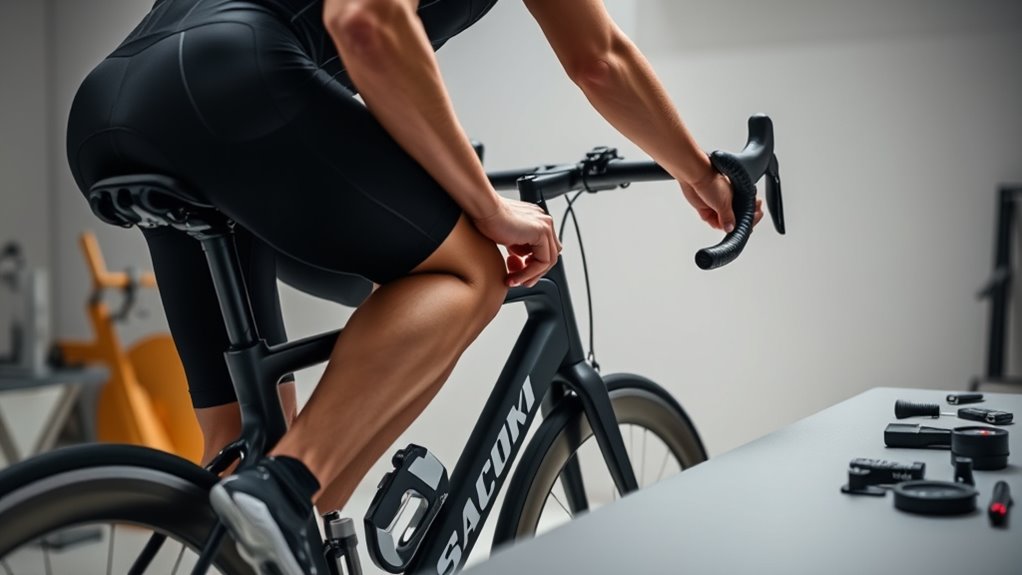
Investing in a customized bike fit offers tangible benefits that can substantially enhance your cycling experience. A professional fitting ensures your bike fit is tailored to your unique anatomy and riding style, leading to improved comfort and efficiency. With personalized adjustments, you’ll enjoy better component placement, such as saddle height and handlebar reach, which can markedly boost performance gains. A customized fit can increase pedaling efficiency by 5-10%, translating to more power and less fatigue. It also helps prevent common cycling injuries like knee pain and lower back discomfort, reducing downtime and medical costs. Proper bike setup can optimize your riding posture and biomechanics, further enhancing comfort and performance. Overall, a professional fitting optimizes your bike’s setup, making every ride more comfortable, safer, and more effective. Additionally, understanding the importance of projector technology can help you appreciate how tailored adjustments in equipment setup contribute to overall performance and satisfaction. Recognizing the role of Cultural Intelligence in adapting to different riding environments can further enhance your cycling experience across diverse terrains and cultures. Furthermore, a proper fit can positively influence your cycling biomechanics, leading to more efficient energy transfer and reduced strain on muscles and joints.
Components and Techniques Used During a Fitting Session

During a bike fitting session, you’ll encounter advanced assessment tools like 3D motion capture systems and pressure mapping pads that analyze your movement and contact points in real time. Technicians then make precise adjustments to components such as saddle height, handlebar reach, and stem length based on detailed biomechanical data. Video analysis and custom insoles further refine your position, ensuring ideal comfort and efficiency. Additionally, understanding retail hours can be useful if you need to visit a store for fitting accessories or equipment. Incorporating field recording techniques can also assist in capturing the environment to better customize your riding experience, especially when considering outdoor conditions. Proper use of headphone jacks can enhance audio feedback during training or consultation sessions. A comprehensive understanding of bike component adjustments allows for more precise and personalized tuning during the fitting process. Staying informed about latest cycling technology can help you benefit from new innovations that improve performance and comfort.
Assessment Tools Utilized
Professional bike fitting sessions leverage a variety of advanced assessment tools to analyze rider biomechanics and optimize comfort and performance. Motion capture systems like Retul or Bioracer track your movements in real-time, providing precise data on joint angles and pedaling mechanics. Pressure mapping with saddle pressure pads and insoles assesses weight distribution, helping you find optimal saddle and foot positioning. Software analysis consolidates biometric data, joint angles, and pressure points into detailed reports, guiding adjustments. Pressure pads detect areas of excessive load, while adjustable trainers simulate real riding conditions, enabling dynamic measurements. Video analysis software offers multiple-angle views of your posture and movement, ensuring accurate evaluation. These tools work together to create a personalized, data-driven approach that enhances your riding efficiency and comfort.
Adjustment Techniques Applied
Adjustment techniques during a bike fitting focus on fine-tuning key components to enhance comfort and efficiency. You’ll see adjustments such as:
- Saddle height, fore/aft position, and tilt for ideal pedaling. Proper saddle positioning can significantly reduce discomfort and improve power transfer.
- Handlebar modifications including stem length, height, and width. These adjustments can influence your posture and reach, contributing to overall comfort.
- Cleat positioning to ensure proper foot alignment and power transfer. Precise cleat placement can prevent injuries and optimize pedaling efficiency.
- Use of pressure mapping and biomechanical assessment to guide small tweaks. Incorporating pressure distribution analysis helps identify areas of excessive pressure and adjust accordingly.
- Component adjustments based on rider feedback to improve reach and control. Your fitter analyzes how each adjustment affects your biomechanics and overall riding experience, ensuring every tweak brings you closer to a personalized, efficient setup. This meticulous process helps prevent discomfort and maximizes performance.
- Incorporating air quality considerations can also contribute to overall comfort during long rides by ensuring a healthier breathing environment.
- Additionally, paying attention to ergonomic design principles can enhance overall comfort and reduce fatigue, making your rides more enjoyable and sustainable. Moreover, understanding biomechanical principles can further refine the fit and optimize your riding efficiency, especially when combined with lifestyle adaptations for better overall well-being.
How a Bike Fitter Assesses Your Unique Body and Riding Style

To effectively tailor a bike fit, a fitter starts by examining your body’s measurements, including limb lengths, flexibility, and joint mobility, to understand how your anatomy influences riding. They perform a thorough body assessment, analyzing your posture and observing how your body interacts with the bike. Your riding style, goals, and any discomfort or injuries are also considered to determine the best setup. The fitter may use tools like motion capture systems and pressure sensors to monitor your pedaling mechanics and body movements in real-time. This biomechanical analysis helps identify asymmetries or imbalances that could affect performance or cause discomfort. Incorporating body symmetry assessments can further enhance the fit by addressing potential imbalances that might impact comfort and performance. Additionally, understanding posture and alignment allows for adjustments that promote better ergonomics and reduce strain during rides. By combining measurements, observations, and technology, the bike fitter creates a personalized fit designed to optimize comfort, efficiency, and injury prevention tailored specifically to you.
Differences Between Various Types of Bike Fitting Services
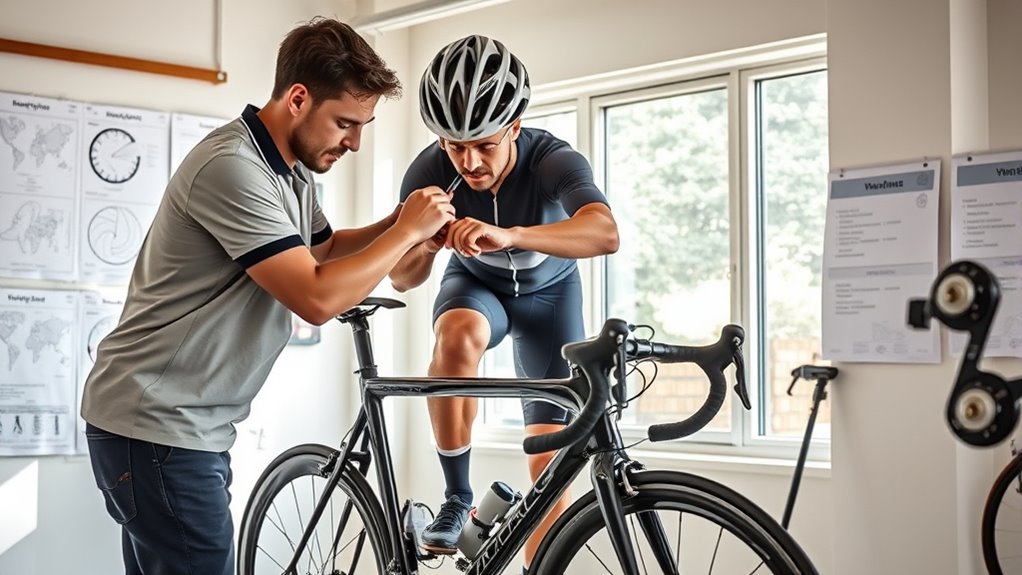
Bike fitting services vary widely in the technologies they use and the depth of analysis they provide. Some employ advanced tools like 3D motion analysis (Retul), pressure mapping (Bioracer), or video recording (Selle Italia’s idMatch) to create precise, tailored positioning. Others focus on discipline-specific fits, such as triathlon or mountain biking, customizing adjustments to suit different riding styles. The fit duration ranges from quick 20-minute tweaks to extensive sessions lasting up to three hours, including biomechanical assessments. Costs also vary, from around $100 for basic adjustments to several hundred dollars for technology-driven, detailed fittings. Specialized tools and software help optimize the process, with some providers offering follow-up sessions or guarantees to ensure lasting comfort and performance.
The Impact of Proper Fitting on Comfort, Performance, and Safety
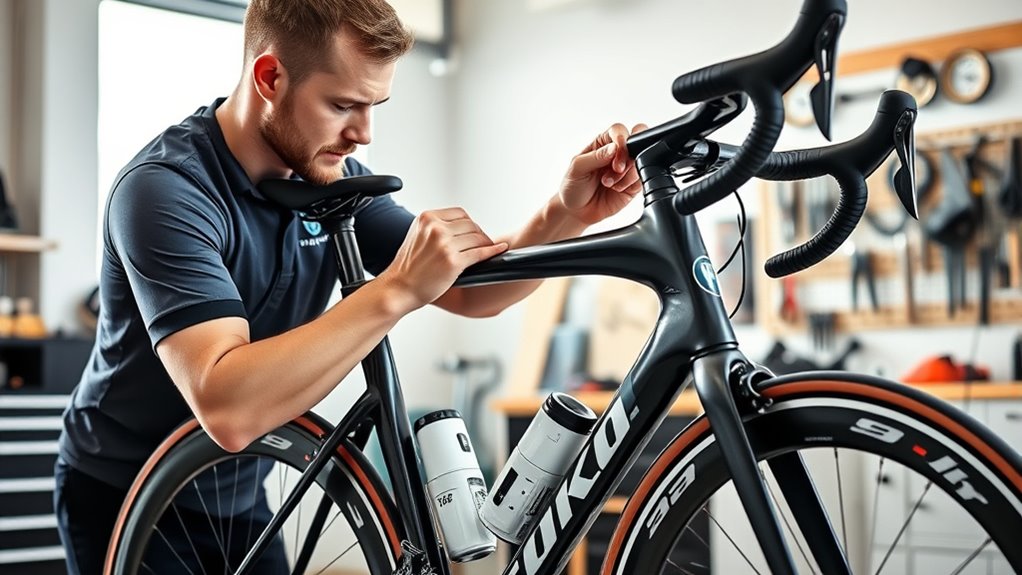
When your bike fits properly, you’ll notice immediate benefits in comfort, performance, and safety. A correct bike fit optimizes contact points, like the saddle position and handlebar setup, reducing discomfort and pain during rides. This improved fit enhances biomechanics, allowing you to generate more power and ride with greater efficiency. Better contact points mean increased riding comfort and less strain, helping prevent injury by reducing overuse issues like knee, back, and neck pain. Proper fitting also boosts safety by providing better control, handling, and access to brakes and steering. When your bike is correctly adjusted, you’ll enjoy smoother rides, improved endurance, and increased speed—all thanks to a fit that supports your body’s natural movements and maximizes performance.
When and Why to Revisit Your Bike Fit

Periodic reassessment of your bike fit is essential because your body changes over time, affecting your ideal positioning. Staying on top of fit reviews ensures you maintain proper alignment and avoid discomfort or injury. You should revisit your bike fit when:
- You experience new discomfort or numbness during cycling
- You notice decreased pedaling efficiency or persistent pain
- You’ve had body changes like weight fluctuations or injuries
- You upgrade or buy a new bike with different geometry
- After several hundred riding hours to optimize cycling health
A professional fit reevaluation helps identify issues early, preventing injuries and improving comfort. Regular check-ins keep your cycling performance at its best, ensuring your bike fit supports long-term health and enjoyment.
Choosing a Qualified Professional for Your Bike Fitting Needs
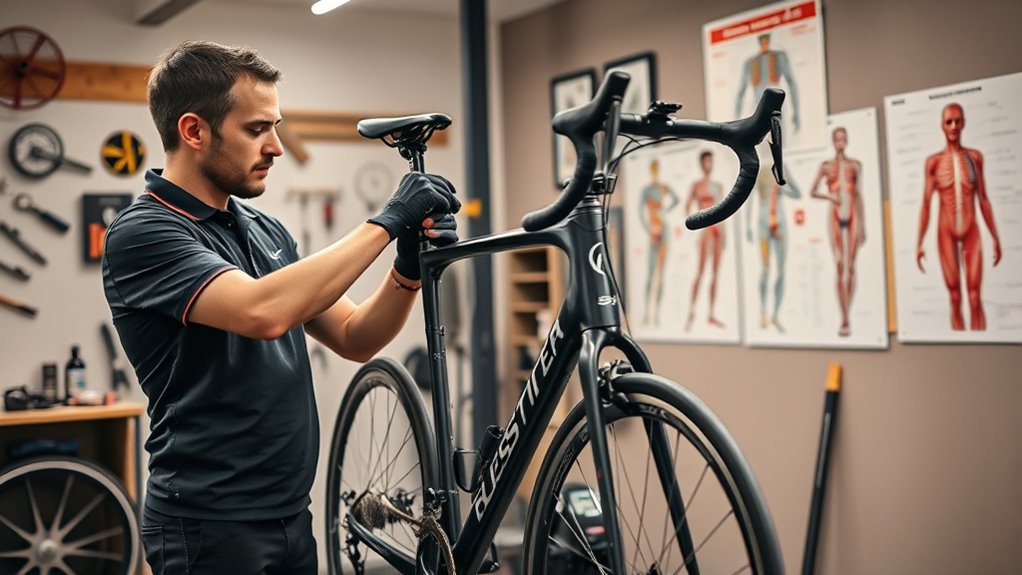
Choosing a qualified professional for your bike fitting guarantees you receive accurate adjustments that prioritize your comfort and safety. Look for a qualified bike fitter with relevant certifications from organizations like IBFI, demonstrating their credibility and commitment to best practices. Experience matters—seek professionals who have worked with a variety of riders or athletes, ensuring a thorough bike fitting process. A reputable bike fit service will assess your biomechanics, flexibility, and riding goals before making adjustments. Using advanced tools like 3D motion analysis or pressure mapping enhances precision and effectiveness. To help you evaluate, consider this:
| Attribute | Why It Matters |
|---|---|
| Certifications | Validates expertise and credibility |
| Experience | Ensures diverse rider knowledge |
| Biomechanics skills | Personalizes your fit |
| Advanced tools | Improves accuracy |
| Industry credibility | Indicates professionalism |
Frequently Asked Questions
What Is the Importance of Bike Fitting?
Bike fitting is essential because it guarantees your riding position is ideal, reducing the risk of injuries and discomfort. When your bike fits properly, you’ll ride more efficiently, with better power transfer and less fatigue. It also helps identify any misalignments or asymmetries that could cause long-term issues. Regular fittings keep your bike setup in tune with your body changes, helping you stay comfortable and perform at your best.
What Is the Rule of Thumb for Bike Fitting?
Think of bike fitting as tuning a fine instrument. The rule of thumb suggests setting your saddle so that your knee is slightly bent (25-35 degrees) at the bottom of the pedal stroke. Use about 0.88 to 1.00 times your inseam for saddle height. Adjust handlebar reach and height for comfort, keeping a slight bend in your elbows. These guidelines give you a solid starting point for a comfortable ride.
What Is the Purpose of a Bike Trainer?
A bike trainer lets you ride your bike indoors, so you can train or maintain your fitness year-round. It provides a stable, controlled environment to improve your pedaling efficiency, build endurance, or work on specific workouts. Whether it’s wheel-on or direct-drive, a trainer helps you stay consistent with your cycling routine, regardless of weather or time of day. It’s a great tool for focused training and bike maintenance.
What Are the Points for Bike Fitting?
When considering bike fitting points, you focus on adjusting saddle height, handlebar position, and cleat placement to match your body and riding style. You’ll want to make certain your posture is comfortable, your pedaling is efficient, and pain is minimized. Properly aligning these components helps prevent injuries and boosts performance. By fine-tuning these details, you make sure your bike fits you perfectly, so every ride feels smoother and more enjoyable.
Conclusion
Investing in a professional bike fit isn’t just a good idea—it’s a game-changer that transforms your entire riding experience. With the right fit, you’ll access untapped power, crush your limits, and ride pain-free for miles on end. Don’t settle for discomfort or mediocre performance—demand the best for your body and your passion. Get fitted by a pro and watch your cycling world explode into a new domain of comfort, speed, and joy!







